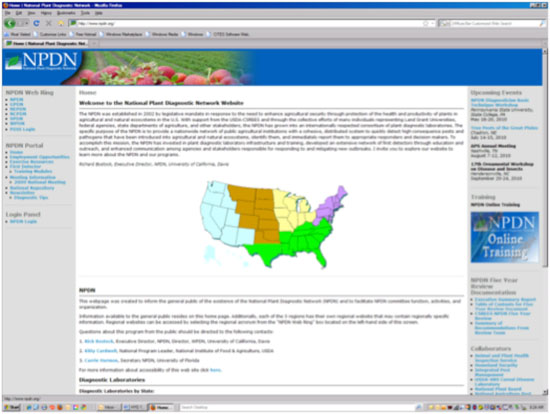Issue 6, May 28, 2010
Helpful Info from NPDN
The National Plant Diagnostic Network (NPDN) is indeed a network of people employed at land grant universities, federal agencies (such as APHIS), and state departments of agriculture, consultants, and other stakeholders. Since 2002 this network has provided diagnosticians and clinics, such as ours at the University of Illinois, with funding for equipment, support personnel, training, and travel to training. It has provided a perfect venue for working with diagnosticians around the globe. I could go on and on about the wonderful opportunities NPDN has provided plant clinics, but it also has plenty to offer consultants, growers, and individuals.
The home site for NPDN is http://www.npdn.org/. Notice that each region can be accessed through bullets on the upper left of the page. Many of the informational items can be found in the specific regions. I personally find the most in the Southern region but, of course, not all applies to Illinois.

On-line crop biosecurity modules are offered free of charge. These modules are excellent for anyone who monitors the health of crops, diagnosticians, or students. The training helps users recognize high risk pests or select agents, establish communication with local and state "go-to" folks, and understand the goals and mission of NPDN. To take this on-line training, register at cbc.at.ufl.edu and click on "Take the On-Line Training Modules."
Geranium and potato/tomato growers seem to have little in common. Unfortunately, they both share the threat of a devastating disease called bacterial wilt, caused by Ralstonia solanacearum race 3 biovar 2. Fortunately the pathogen has not become established in the US. It has made several attempts but has been thwarted by vigilant inspectors. An on-line module is available as part of a USDA-NRI project. Ralstonia solanacearum race 3 biovar 2 e-learning can be accessed as indicated for the biosecurity modules.
At a recent NPDN meeting/training, I learned of Lucid keys. These are keys to help with identification of plants, insects, pathogens, etc. Some can be purchased and some are free. You do not have to follow a set pathway in Lucid keys. In a traditional key you might not be able to proceed on an insect ID if the antennae are missing. Lucid keys let you jump into the key at any point where you have a known character, such as wing placement. It systematically eliminates possibilities. There is an excellent Lucid key available to help with identification of wood boring beetles. It is a collaboration among USDA/APHIS/PPQ-CPHST, California Department of Food and Agriculture, and Montana State University. The key helps users, even non-entomologists, make accurate identifications. Give it a try.--Nancy Pataky
Author:
Nancy Pataky